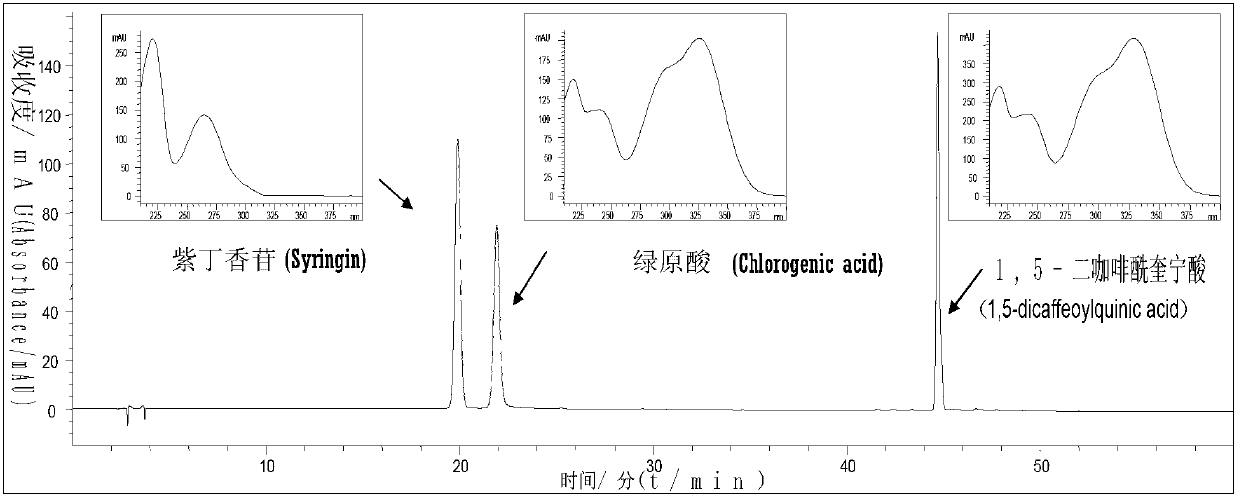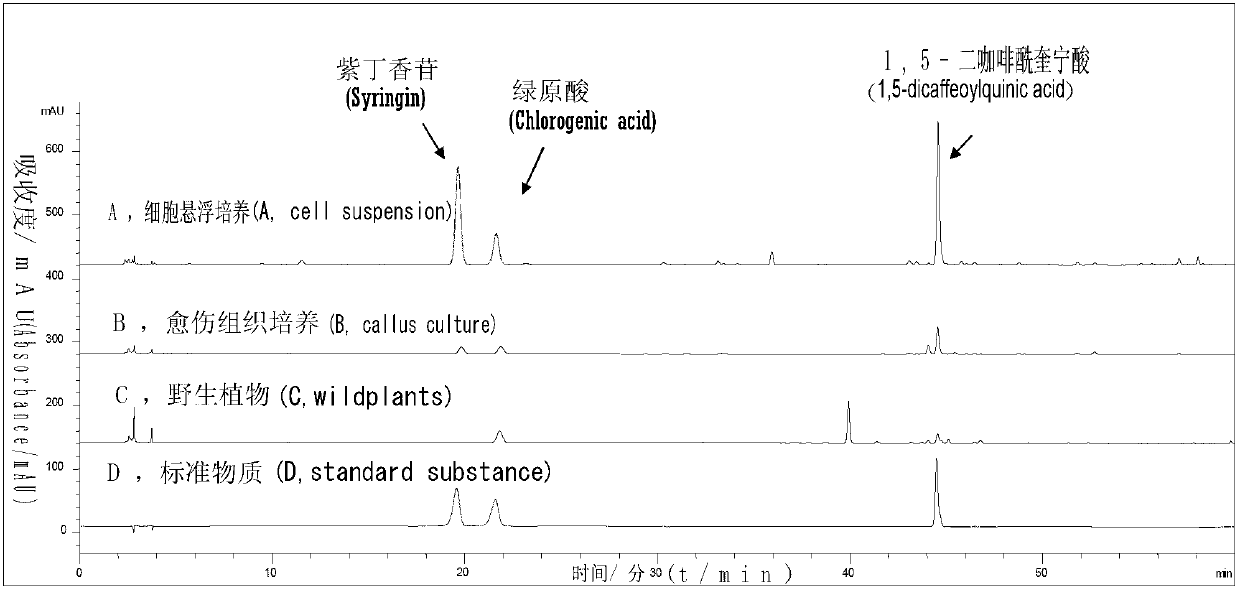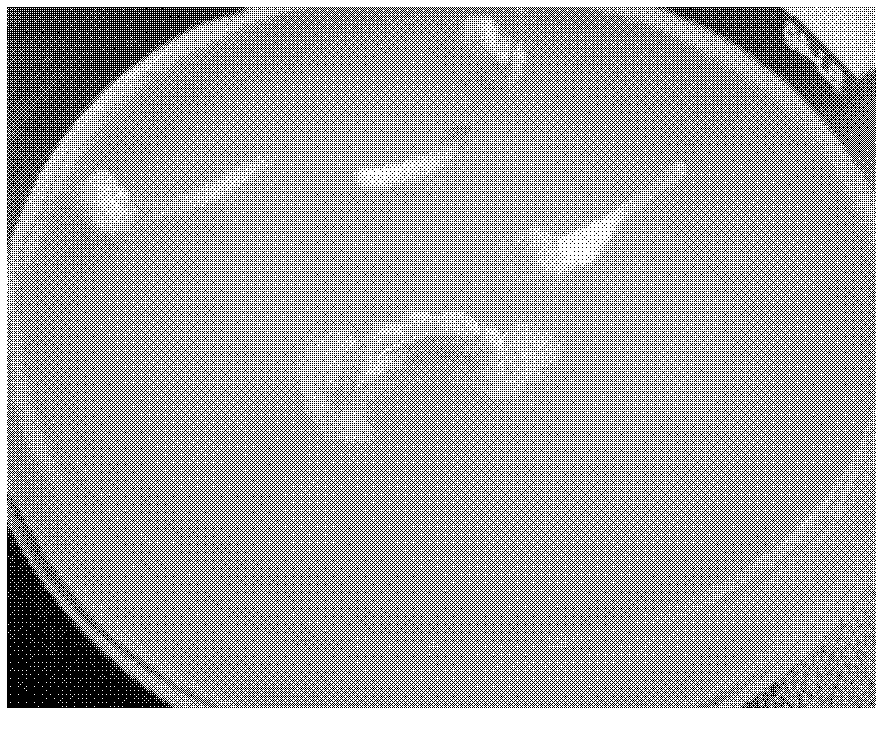Method for producing Syringin, chlorogenic acid and 1, 5-dicaffeoylquinic acid by cell culture of herba saussureae involucratae
A technology of caffeoylquinic acid and syringin, which is applied in the directions of biochemical equipment and methods, chemical instruments and methods, plant cells, etc., can solve the problems of non-disclosure, etc., and achieves strong production capacity, stable and controllable quality, and ease of use. The effects of the resource crisis
- Summary
- Abstract
- Description
- Claims
- Application Information
AI Technical Summary
Problems solved by technology
Method used
Image
Examples
Embodiment 1
[0079] Example 1, Screening of Saussurea sativa cell line with high yield of syringin, chlorogenic acid and 1,5-dicaffeoylquinic acid
[0080] The tissues and organs derived from wild Saussurea tianshanensis plants, regenerated seedlings or aseptic seedlings after germination are used as explants, preferably aseptic seedling leaves or hypocotyls after seed germination, to induce the production of isolated tissue cells, and the induction medium is Additional 0.1~2.0mg·L -1 NAA, 0.1~2.0mg·L -1 6-BA and 0.1~2.0mg·L -1 2,4-D hormone combination, and subculture in the same composition of medium to screen high-producing cell lines. For the subculture, the loose and light yellow tissue cells with good growth status were selected as seeds, and the whole cultivation process was carried out in the dark, subcultured once every 10 days, combined with the analysis of secondary metabolite components to screen and cultivate for more than 1 year, and high-yield syringin, syringin, and Chlo...
Embodiment 2
[0084] Example 2, the establishment of a high-yield syringin, chlorogenic acid and 1,5-dicaffeoylquinic acid Saussurea sauraceae cell suspension system
[0085] The Saussurea tianshanensis cell line with high yields of syringin, chlorogenic acid and 1,5-dicaffeoylquinic acid obtained through screening was transferred into liquid medium for suspension culture in shake flasks. The bed is rotated and shaken for culture, and the speed of the shaker is 80-140r·min -1 , the inoculum amount is 5-10 g dry weight of cells per liter of medium, and the suspension culture is carried out under dark conditions. Subculture once every 8d to 10d, after 3 to 4 generations, a stable and high-yield syringin, chlorogenic acid and 1,5-dicaffeoylquinic acid suspension cell culture system of Saussurea chinensis was established, and the cells in the suspension system showed the Granular, good dispersion, rapid growth, the biomass per liter of medium can reach 25g~30g dry cell weight.
[0086] Prepar...
Embodiment 3
[0087] Embodiment 3, the cell suspension system of Snow Lotus Tianshan is used for mass production of syringin, chlorogenic acid and 1,5-dicaffeoylquinic acid
[0088] By adding phenylpropanoids to synthesize precursor L-phenylalanine at the initial stage of culture, and adding elicitor methyl jasmonate during the culture process, the production of syringin, chlorogenic acid and 1 in Snow Lotus cells can be improved, 5-dicaffeoylquinic acid capacity.
[0089] Preparation and culture method of production medium: the production of active ingredients adopts additional 0.1-2.0mg·L -1 NAA, 0.1~2.0mg·L -1 6-BA and 0.1~2.0mg·L -1 2, 4-D hormone combination, and add 3% to 8% sucrose, add 10 to 100mg·L on the 4th to 8th day of culture -1 Methyl jasmonate, harvested on the 12th to 14th day of cultivation, the biomass per liter of the medium can reach 21g to 26g, and the yields of syringin, chlorogenic acid and 1,5-dicaffeoylquinic acid can reach 500 to 500g respectively by HPLC analy...
PUM
 Login to View More
Login to View More Abstract
Description
Claims
Application Information
 Login to View More
Login to View More - R&D
- Intellectual Property
- Life Sciences
- Materials
- Tech Scout
- Unparalleled Data Quality
- Higher Quality Content
- 60% Fewer Hallucinations
Browse by: Latest US Patents, China's latest patents, Technical Efficacy Thesaurus, Application Domain, Technology Topic, Popular Technical Reports.
© 2025 PatSnap. All rights reserved.Legal|Privacy policy|Modern Slavery Act Transparency Statement|Sitemap|About US| Contact US: help@patsnap.com



